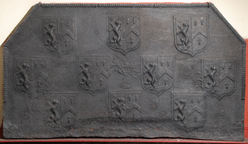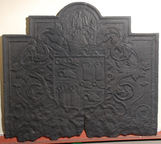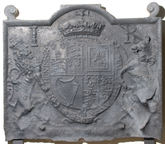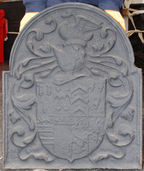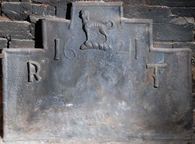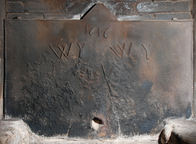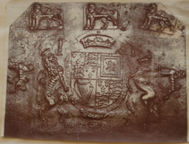-
385
Description: Rectangular with two-stepped top; plain plate; date across lower step; rope saltire in upper step; initials split below outer shoulders.
Notes: The distinctive hand-formed characters on this and some other stepped firebacks imply a common source. Although the talbot crest, by which other firebacks in the series are identified, is absent on this casting, the shape and the style of the characters places it incontrovertably in the same group. Formerly part of the J. H. Every collection.
Inscription: 1615 / R T
- Decoration tags:
- stepped (shape)
- none (edging)
- simple stamps
- individual letters
- individual numbers
- text
- objects
Manufactured: in 1615 in the Weald area of England.
Current location: Anne of Cleves House, Southover High Street, Lewes, East Sussex, England.
Museum number: 1944.24.050 (part of the Sussex Archaeological Society museum group)
Citation: Anon., 30 Dec 1911, 'Sussex Backs and their Story', The Ironmonger.
Citation: Hughes, G. B., 21 Apr 1955, 'Old English Firebacks', Country Life, 117, pp. 1056-60.
Citation: Hughes, G. B., May 1940, 'Old English Firebacks', Apollo, 31, 185, pp. 117-120.
- Attached to series:
- Stepped firebacks
- Talbot crest series
-
388
Description: Rectangular, with canted top corners; twisted rope edging (top and sides only); ten shields of Ayloffe impaling Sulyard in three rows, 3-4-3; Ayloffe: sable, a lion rampant Or, collared gules, between three crosses formy of the second; Sulyard: argent, a chevron gules between three pheons inverted sable.
Notes: William Ayloffe (c1535-1584) of Bretons, Hornchurch, Essex, Justice of the Court of Queen’s Bench, married (c1560) Jane, dau. of Sir Eustace Sulyard, of Runwell, Essex. Formerly part of the J. H. Every collection.
Arms: Ayloffe impaling Sulyard (William Ayloffe of Bretons, Hornchurch)
- Decoration tags:
- rectangular with canted top corners (shape)
- rope (edging)
- carved stamps
- armorial
Manufactured: in the early-17th century possibly in the Weald area of England.
Current location: Anne of Cleves House, Southover High Street, Lewes, East Sussex, England.
Museum number: 1944.24.047 (part of the Sussex Archaeological Society museum group)
- Attached to series:
- Ayloffe series
- Personal armorial firebacks
-
394
Description: Rectangular, with arched rectangular extension on top; double astragal edging (top & sides); shield, helmet, crest and mantling of the Pelham family: quarterly, 1st and 4th, Azure, three pelicans vulning themselves proper; 2nd and 3rd, Gules, two broken belts palewise the buckles upwards argent; the crest: a peacock in pride argent.
Notes: The arms may be those of Sir Nicholas Pelham (1517-59) or of one of his two sons, Sir John (d. 1580) or Sir Thomas (c1540-1624); the latter was created a Baronet in 1611. As there is no evidence of the augmentation of a baronet on the arms, the fireback probably predates the creation of the baronetcy. Formerly part of the J. H. Every collection.
Copies of this fireback are known.
Arms: Sir Nicholas, Sir John or Sir Thomas Pelham
- Decoration tags:
- rectangular with round arch (shape)
- double astragal (edging)
- whole carved pattern
- armorial
Manufactured: in the early-17th century possibly at Waldron Furnace in the Weald area of England.
Current location: Anne of Cleves House, Southover High Street, Lewes, East Sussex, England.
Museum number: 1944.24.054 (part of the Sussex Archaeological Society museum group)
- Attached to series:
- Pelham family firebacks
- Personal armorial firebacks
- Low relief armorial series
-
406
Description: Arched rectangular shaped; convex moulding (top and sides surviving); scrolled protrusions above top corners; Stuart royal shield, crown, garter, supporters and motto; initials separated by crown.
Notes: The scrolled protrusions suggest a possible association with other firebacks with similar features.
Inscription: I R / HONI SOIT QVI MAL Y PENSE
Arms: English Stuart royal - James I
- Decoration tags:
- rectangular with round arch (shape)
- convex (edging)
- whole carved pattern
- armorial
- royal
- text
Manufactured: in the early-17th century possibly in the Weald area of England.
Current location: Anne of Cleves House, Southover High Street, Lewes, East Sussex, England.
Museum number: LH000.944 (part of the Sussex Archaeological Society museum group)
-
454
Description: Arched rectangular shape; rebated fillet edging; shield, helm, crest and mantling of the family of Barttelot of Stopham, Sussex.
Notes: The shield is divided into eight quarters (from left) top: Barttelot, Stopham, Lewknor, Doyley; bottom: Tregoz, Camoys, Walton and Sykeston; arms granted in this form in 1616. Walter Bartlett/Barttelot ran Pallingham furnace in the early 17th century, suggesting a possible place of manufacture.
Copies of this fireback are known.
Arms: Barttelot of Stopham
- Decoration tags:
- rectangular with round arch (shape)
- rebated fillet (edging)
- whole carved pattern
- armorial
Manufactured: in the early-17th century possibly at Pallingham Furnace, Wisborough Green in the Weald area of England.
Current location: Hall Place, Bexley, Kent, England.
Museum number: 1931.21.005 (part of the Sussex Archaeological Society museum group)
- Attached to series:
- Personal armorial firebacks
-
945
Description: Rectangular with two-stepped top; twisted rope edging (top and sides) formed of short rope sections, with top vertical sections extending down beyond the join with the next horizontal section; top centre, stamp formed of a talbot statant guardant upon a wreath; date separated by crest stamp; initials below and separated by date.
Notes: The talbot crest has been seen on other firebacks indicating a common source.
Inscription: 16 21 / R T
- Decoration tags:
- stepped (shape)
- rope (edging)
- simple stamps
- carved stamps
- individual letters
- individual numbers
- heraldic
- text
Manufactured: in 1621 in the Weald area of England.
Current location: in private hands, Lindfield, West Sussex, England.
- Attached to series:
- Talbot crest series
- Stepped firebacks
-
975
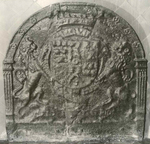 ? x ? mmImage subject to copyright
? x ? mmImage subject to copyrightDescription: Arched shape; double-fillet edged arched border, with six evenly-spaced roses, resting on pilasters; shield, supporters, garter and coronet of the Earl of Exeter; plain rectangular bottom panel.
Notes: The arms are of the earldom of Exeter, which was created in 1605 for Thomas Cecil, 2nd Lord Burghley (1542-1623).
Inscription: HONY SOIT QVI MAL Y PENSE [illegible]
Arms: Cecil, Earls of Exeter
- Decoration tags:
- rounded arched (shape)
- fillet (edging)
- whole carved pattern
- armorial
Manufactured: in the early-17th century in Wales.
Current location: Plas Llanmihangel, Llanmihangel, Glamorgan, Wales.
Museum number: GL 7628 (part of the National Monuments Record of Wales museum group)
- Attached to series:
- Personal armorial firebacks
-
471
Description: Rectangular with small central triangle on top; twisted rope edging (top and sides) and across base of triangle; top centre, date, centrally positioned above the separated pairs of initials, WY; below and right of centre, rope saltire; bottom centre, a hole apparently puncturing the plate from behind.
Notes: The initials are those of William Yalden (1580-1659), an ironmaster who was active in north-west Sussex and south-west Surrey where this and other similar firebacks have been noted. The saltire is likely to have had an apotropaic purpose. Although undoubtedly connected with the builder of the house wherein it rests, the fireback pre-dates the building, which was erected in 1640.
Inscription: 1616 / WY WY
- Decoration tags:
- rectangular with triangular arch (shape)
- rope (edging)
- simple stamps
- individual letters
- individual numbers
- apotropaic
- text
Manufactured: in 1616 in the Weald area of England.
Current location: in private hands, Lodsworth, West Sussex, England.
- Attached to series:
- William Yalden series
- Date & initials firebacks
-
480
Description: Arched rectangle; ovolo, egg-and-dart moulded edging; shield, helm, coronet, crest and mantling; curved inscription panel below shield.
Notes: The heraldic devices on the shield, and the form of the helm and crest suggest this may be a continental achievement of arms; the style of the fireback is, however, is more characteristic of English types.
Copies of this fireback are known.
Inscription: ... D HADRIANI ... EQVITE DOM DE HE.. / ... M.. ... ... [?]
Arms: not known
- Decoration tags:
- rectangular with round arch (shape)
- egg and dart (edging)
- whole carved pattern
- planklines
- armorial
- text
Manufactured: in the early-17th century .
Current location: Maidstone Museum, St Faith's Street, Maidstone, Kent, England.
(part of the Maidstone Museum museum group)
- Attached to series:
- Personal armorial firebacks
-
1036
Description: Canted rectangular shape; no edging; lower centre, carved pattern panel of Stuart Royal arms: shield, garter, crown, motto, supporters and initials, RI separated by crown; lion statant guardant stamp repeated five times, three across top, one each side feet to left.
Notes: The impression of the decorative elements is irregular, with the achievement of arms under-pressed and the three lion stamps along the top over-pressed; the distinctive feature of the unicorn's horn in front of the initial R has been seen on a small number of other firebacks. From a photograph in the J. Starkie Gardner Collection, Victoria & Albert Museum, Archive of Art and Design (AAD/2014/8).
Inscription: I R
Arms: English Stuart royal - James I
- Decoration tags:
- rectangular with canted top corners (shape)
- none (edging)
- carved stamps
- carved pattern panels
- heraldic
- armorial
- royal
- text
- animals
Manufactured: in the early-17th century possibly in the Weald area of England.
Current location: Maidstone Museum, St Faith's Street, Maidstone, Kent, England.
(part of the Maidstone Museum museum group)

